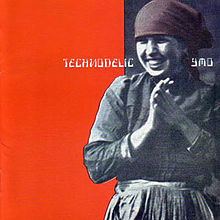Released November 21, 1981 Technodelic(1981) Naughty Boys(1983) Release date 21 November 1981 | Length 43:29 Label Alfa Records | |
 | ||
Recorded March 21 – October 13, 1981 Producer Haruomi HosonoYellow Magic OrchestraShōrō Kawazoe (Executive) Genres Techno, Rock music, Electropop, Electro, Electronic dance music, New wave, Electronic music Similar Yellow Magic Orchestra albums, Electropop albums | ||
Technodelic is the fifth studio album by Yellow Magic Orchestra, released in 1981. The album is notable for its experimental and heavy use of samplers which were not commonly used until the mid-to-late 1980s, resulting in a more minimalist sound compared to their previous work.
Contents
It is considered the first released album to feature mostly samples and loops, influencing the heavy use of sampling and looping in popular music. Yellow Magic Orchestra's approach to sampling music was a precursor to the contemporary approach of constructing music by cutting fragments of sounds and looping them using computer technology.
Pure jam ymo
Production
Most of the sampling was made with an LMD-649 - a hand-made sampler developed by Toshiba-EMI engineer Kenji Murata, and a much cheaper alternative to the Linn LM-1 drum machine and Fairlight CMI sampling synthesizer available at the time. Notable samples used include Indonesian kecak chanting (Neue Tanz), gamelan and short looped vocals ("paa", "fuku", "chiki") for percussion in "Seoul Music," and the final two tracks feature factory noises. The album also features use of speech through a two-way radio, a prepared piano, Prophet-5 synthesizers, and a TR-808 drum machine. In another departure from previous albums, Haruomi Hosono has a more prominent role playing the bass guitar as opposed to playing bass lines on synthesizers (this trend appears again on the album Service).
As with many of YMO's releases, song titles are printed in both Japanese and English. For "Seoul Music", the kanji "京城" are used, referring to Gyeongseong (경성; known as Keijou in Japan), the name of Seoul when Korea was under Japanese rule. "灯" simply translates to "Light". "Neue Tanz" is German for "New Dance", while "Taisō" is Japanese for "gymnastics" or "calisthenics".
Personnel
Songs
1Pure Jam4:31
2Neue Tanz5:00
3Stairs4:16
